Maksym Lysak
IBM Research
SmolDocling: An ultra-compact vision-language model for end-to-end multi-modal document conversion
Mar 14, 2025Abstract:We introduce SmolDocling, an ultra-compact vision-language model targeting end-to-end document conversion. Our model comprehensively processes entire pages by generating DocTags, a new universal markup format that captures all page elements in their full context with location. Unlike existing approaches that rely on large foundational models, or ensemble solutions that rely on handcrafted pipelines of multiple specialized models, SmolDocling offers an end-to-end conversion for accurately capturing content, structure and spatial location of document elements in a 256M parameters vision-language model. SmolDocling exhibits robust performance in correctly reproducing document features such as code listings, tables, equations, charts, lists, and more across a diverse range of document types including business documents, academic papers, technical reports, patents, and forms -- significantly extending beyond the commonly observed focus on scientific papers. Additionally, we contribute novel publicly sourced datasets for charts, tables, equations, and code recognition. Experimental results demonstrate that SmolDocling competes with other Vision Language Models that are up to 27 times larger in size, while reducing computational requirements substantially. The model is currently available, datasets will be publicly available soon.
Docling: An Efficient Open-Source Toolkit for AI-driven Document Conversion
Jan 27, 2025



Abstract:We introduce Docling, an easy-to-use, self-contained, MIT-licensed, open-source toolkit for document conversion, that can parse several types of popular document formats into a unified, richly structured representation. It is powered by state-of-the-art specialized AI models for layout analysis (DocLayNet) and table structure recognition (TableFormer), and runs efficiently on commodity hardware in a small resource budget. Docling is released as a Python package and can be used as a Python API or as a CLI tool. Docling's modular architecture and efficient document representation make it easy to implement extensions, new features, models, and customizations. Docling has been already integrated in other popular open-source frameworks (e.g., LangChain, LlamaIndex, spaCy), making it a natural fit for the processing of documents and the development of high-end applications. The open-source community has fully engaged in using, promoting, and developing for Docling, which gathered 10k stars on GitHub in less than a month and was reported as the No. 1 trending repository in GitHub worldwide in November 2024.
Docling Technical Report
Aug 19, 2024



Abstract:This technical report introduces Docling, an easy to use, self-contained, MIT-licensed open-source package for PDF document conversion. It is powered by state-of-the-art specialized AI models for layout analysis (DocLayNet) and table structure recognition (TableFormer), and runs efficiently on commodity hardware in a small resource budget. The code interface allows for easy extensibility and addition of new features and models.
KVP10k : A Comprehensive Dataset for Key-Value Pair Extraction in Business Documents
May 01, 2024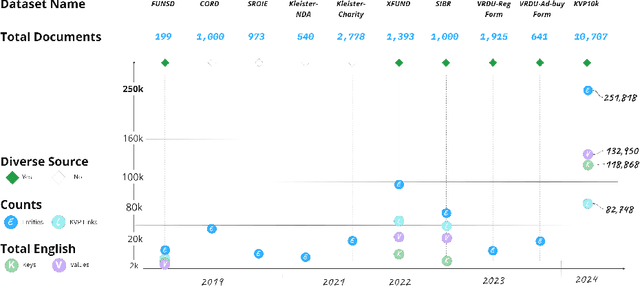

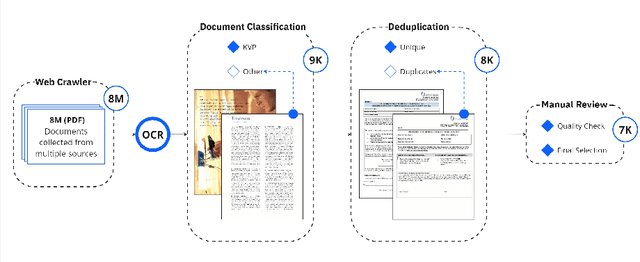
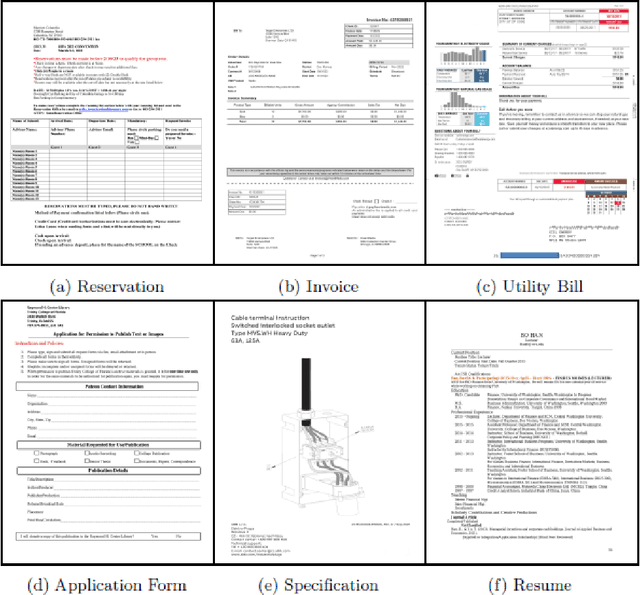
Abstract:In recent years, the challenge of extracting information from business documents has emerged as a critical task, finding applications across numerous domains. This effort has attracted substantial interest from both industry and academy, highlighting its significance in the current technological landscape. Most datasets in this area are primarily focused on Key Information Extraction (KIE), where the extraction process revolves around extracting information using a specific, predefined set of keys. Unlike most existing datasets and benchmarks, our focus is on discovering key-value pairs (KVPs) without relying on predefined keys, navigating through an array of diverse templates and complex layouts. This task presents unique challenges, primarily due to the absence of comprehensive datasets and benchmarks tailored for non-predetermined KVP extraction. To address this gap, we introduce KVP10k , a new dataset and benchmark specifically designed for KVP extraction. The dataset contains 10707 richly annotated images. In our benchmark, we also introduce a new challenging task that combines elements of KIE as well as KVP in a single task. KVP10k sets itself apart with its extensive diversity in data and richly detailed annotations, paving the way for advancements in the field of information extraction from complex business documents.
ESG Accountability Made Easy: DocQA at Your Service
Nov 30, 2023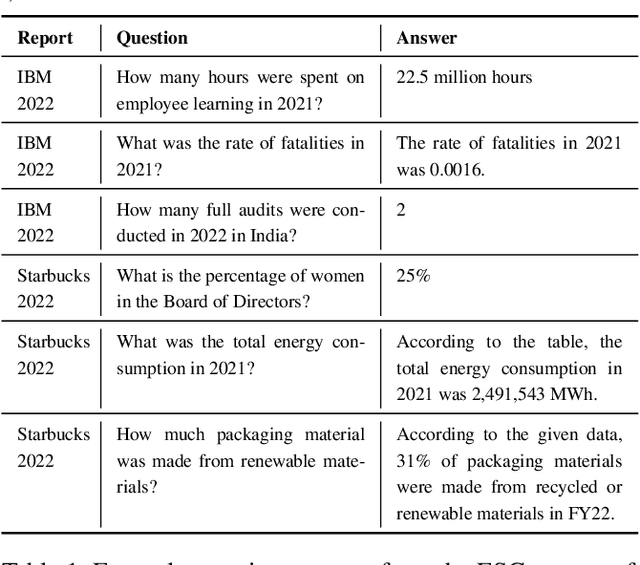

Abstract:We present Deep Search DocQA. This application enables information extraction from documents via a question-answering conversational assistant. The system integrates several technologies from different AI disciplines consisting of document conversion to machine-readable format (via computer vision), finding relevant data (via natural language processing), and formulating an eloquent response (via large language models). Users can explore over 10,000 Environmental, Social, and Governance (ESG) disclosure reports from over 2000 corporations. The Deep Search platform can be accessed at: https://ds4sd.github.io.
ICDAR 2023 Competition on Robust Layout Segmentation in Corporate Documents
May 24, 2023Abstract:Transforming documents into machine-processable representations is a challenging task due to their complex structures and variability in formats. Recovering the layout structure and content from PDF files or scanned material has remained a key problem for decades. ICDAR has a long tradition in hosting competitions to benchmark the state-of-the-art and encourage the development of novel solutions to document layout understanding. In this report, we present the results of our \textit{ICDAR 2023 Competition on Robust Layout Segmentation in Corporate Documents}, which posed the challenge to accurately segment the page layout in a broad range of document styles and domains, including corporate reports, technical literature and patents. To raise the bar over previous competitions, we engineered a hard competition dataset and proposed the recent DocLayNet dataset for training. We recorded 45 team registrations and received official submissions from 21 teams. In the presented solutions, we recognize interesting combinations of recent computer vision models, data augmentation strategies and ensemble methods to achieve remarkable accuracy in the task we posed. A clear trend towards adoption of vision-transformer based methods is evident. The results demonstrate substantial progress towards achieving robust and highly generalizing methods for document layout understanding.
Optimized Table Tokenization for Table Structure Recognition
May 05, 2023Abstract:Extracting tables from documents is a crucial task in any document conversion pipeline. Recently, transformer-based models have demonstrated that table-structure can be recognized with impressive accuracy using Image-to-Markup-Sequence (Im2Seq) approaches. Taking only the image of a table, such models predict a sequence of tokens (e.g. in HTML, LaTeX) which represent the structure of the table. Since the token representation of the table structure has a significant impact on the accuracy and run-time performance of any Im2Seq model, we investigate in this paper how table-structure representation can be optimised. We propose a new, optimised table-structure language (OTSL) with a minimized vocabulary and specific rules. The benefits of OTSL are that it reduces the number of tokens to 5 (HTML needs 28+) and shortens the sequence length to half of HTML on average. Consequently, model accuracy improves significantly, inference time is halved compared to HTML-based models, and the predicted table structures are always syntactically correct. This in turn eliminates most post-processing needs.
TableFormer: Table Structure Understanding with Transformers
Mar 11, 2022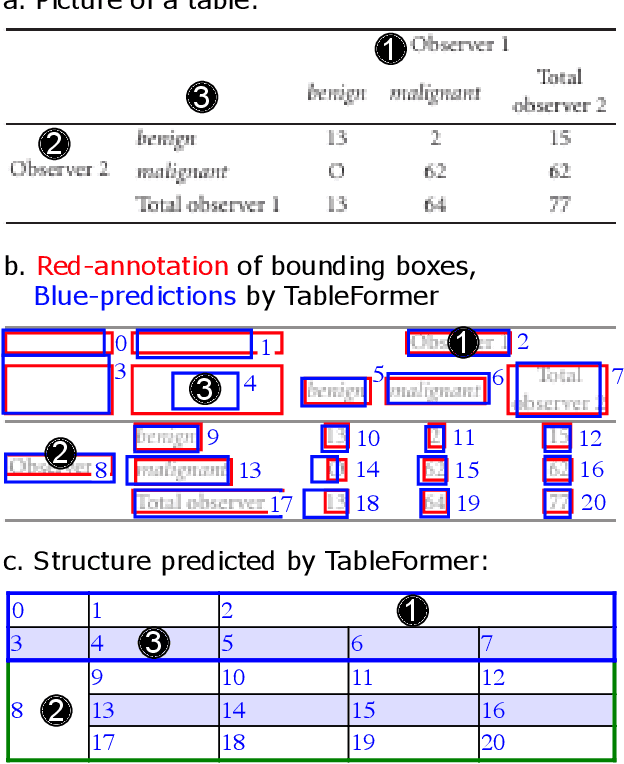



Abstract:Tables organize valuable content in a concise and compact representation. This content is extremely valuable for systems such as search engines, Knowledge Graph's, etc, since they enhance their predictive capabilities. Unfortunately, tables come in a large variety of shapes and sizes. Furthermore, they can have complex column/row-header configurations, multiline rows, different variety of separation lines, missing entries, etc. As such, the correct identification of the table-structure from an image is a non-trivial task. In this paper, we present a new table-structure identification model. The latter improves the latest end-to-end deep learning model (i.e. encoder-dual-decoder from PubTabNet) in two significant ways. First, we introduce a new object detection decoder for table-cells. In this way, we can obtain the content of the table-cells from programmatic PDF's directly from the PDF source and avoid the training of the custom OCR decoders. This architectural change leads to more accurate table-content extraction and allows us to tackle non-english tables. Second, we replace the LSTM decoders with transformer based decoders. This upgrade improves significantly the previous state-of-the-art tree-editing-distance-score (TEDS) from 91% to 98.5% on simple tables and from 88.7% to 95% on complex tables.
Robust PDF Document Conversion Using Recurrent Neural Networks
Feb 18, 2021



Abstract:The number of published PDF documents has increased exponentially in recent decades. There is a growing need to make their rich content discoverable to information retrieval tools. In this paper, we present a novel approach to document structure recovery in PDF using recurrent neural networks to process the low-level PDF data representation directly, instead of relying on a visual re-interpretation of the rendered PDF page, as has been proposed in previous literature. We demonstrate how a sequence of PDF printing commands can be used as input into a neural network and how the network can learn to classify each printing command according to its structural function in the page. This approach has three advantages: First, it can distinguish among more fine-grained labels (typically 10-20 labels as opposed to 1-5 with visual methods), which results in a more accurate and detailed document structure resolution. Second, it can take into account the text flow across pages more naturally compared to visual methods because it can concatenate the printing commands of sequential pages. Last, our proposed method needs less memory and it is computationally less expensive than visual methods. This allows us to deploy such models in production environments at a much lower cost. Through extensive architectural search in combination with advanced feature engineering, we were able to implement a model that yields a weighted average F1 score of 97% across 17 distinct structural labels. The best model we achieved is currently served in production environments on our Corpus Conversion Service (CCS), which was presented at KDD18 (arXiv:1806.02284). This model enhances the capabilities of CCS significantly, as it eliminates the need for human annotated label ground-truth for every unseen document layout. This proved particularly useful when applied to a huge corpus of PDF articles related to COVID-19.
 Add to Chrome
Add to Chrome Add to Firefox
Add to Firefox Add to Edge
Add to Edge